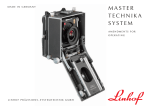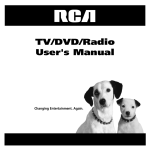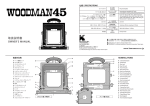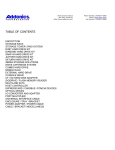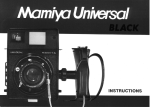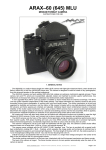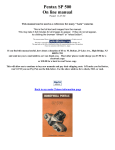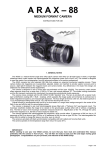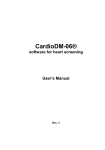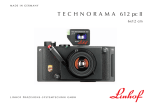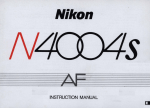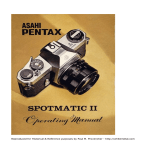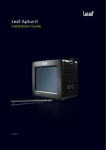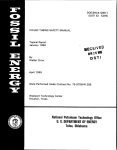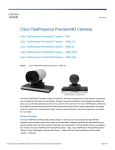Download Linhof Master Technika Classic Operating Instructions
Transcript
MASTER TECHNIKA SYSTEM MADE IN GERMANY LINHOF PRÄZISIONS - SYSTEMTECHNIK GMBH E 1. WELCOME TO THE LINHOF FAMILY MASTER TECHNIKA classic and MASTER TECHNIKA 2000 We would like to congratulate you on acquiring your new LINHOF MASTER TECHNIKA built in the best LINHOF tradition of quality engineering and dedicated craftsmanship. Yet, it is a precision instrument, and you should treat it as such. Make it a habit to protect your camera from dust, sand or spray, and avoid rough handling. All movable parts are free from the necessity of continuous servicing. Keep gliding parts, such as upper track always clean. You may apply a very thin film of chemically pure vaseline to the upper track. Under no circumstances should oil be used. After long years continuous intensive use, periodic inspection and serving may become necessary. In this case we recommend to return the camera to Linhof or an authorized Linhof service station for inspection. Thanks to its drop-bed technique the Technika can completely be closed, easily carried and set up on location. 2 2. CONTENTS 1. 2. 3. 4 5. 6. 7. 8. 9. 10. 11. 12. 13. 14. 15. 16. WELCOME TO THE LINHOF FAMILY (classic and 2000) . . . . . . . . . . . . . . . . . . . . . . . . . . .2 CONTENTS . . . . . . . . . . . . . . . . . . . . . . . . . . . . . . . .3 OPERATING SELEMENTS MASTER TECHNIKA classic . . . . . . . . . . . . . . . . . . .4, 5 THE UNIVERSAL CAMERA BACK MASTER TECHNIKA classic and 2000 . . . . . . . . . . . . .6 OPERATING ELEMENTS AND COMPONENTS MASTER TECHNIKA classic . . . . . . . . . . . . . . . . . . . . .7 OPERATING ELEMENTS MASTER TECHNIKA 2000 . . . . . . . . . . . . . . . . . . . . . .8 OPENING AND CLOSING THE CAMERA (classic and 2000) . . . . . . . . . . . . . . . . . . . . . . . . . . .9 INFINITY POSITION (classic and 2000) . . . . . . . . . .10 DISTANCE SCALES (classic and 2000) . . . . . . . . . . . . . . . . . . . . . . . . . .11 DEPTH-OF-FIELD TABLE (classic and 2000) . . . . . . . . . . . . . . . . . . . . . . . . . .11 TRIPLE EXTENSION (classic and 2000) . . . . . . . . . . .12 GROUNDGLASS FOCUSING (classic and 2000) . . . . . . . . . . . . . . . . . . . . . . . . . .13 WIDE-ANGLE PHOTOGRAPHY (MASTER TECHNIKA classic) . . . . . . . . . . . . . . . . . . .14 WIDE-ANGLE PHOTOGRAPHY WITH MASTER TECHNIKA 2000 . . . . . . . . . . . . . . . .15 WIDE-ANGLE SHOTS USING CAMERA ADJUSTMENTS (classic and 2000) . . . . . . . . . . . . . . .16 RECESSED TECHNIKA LENSBOARD WITH HELICAL FOCUSING MOUNT (MASTER TECHNIKA classic) . . .17 17. INTERCHANGE OF LENSES (classic and 2000) . . . . . .18 18. TECHNIKA LENSBOARD WITH ADDED COMFORT (classic and 2000) . . . . . . . . . . . . . . . . . . . . . . . . . .19 19. INTERCHANGE OF COUPLING CAMS (MASTER TECHNIKA classic) . . . . . . . . . . . . . . . . . . .20 20. RANGEFINDER FOCUSING (MASTER TECHNIKA classic) . . . . . . . . . . . . . . . . . . .21 21. CAMERA MOVEMENTS (classic and 2000) . . . . . . . . .22 22. ADJUSTMENTS OF LENS STANDARD (classic and 2000) . . . . . . . . . . . . . . . . . . . . . . .23, 24 23. THE UNIVERSAL CAMERA BACK: THE SWING FRAME (classic and 2000) . . . . . . . . . . .25 24. THE UNIVERSAL CAMERA BACK: THE REVOLVING FRAME (classic and 2000) . . . . . . .27 25. FILM HOLDERS (classic and 2000) . . . . . . . . . . . . . . . . . . . . . . . . . .28 26. ADAPTER FOR DIGITAL BACKS (classic and 2000) . . . . . . . . . . . . . . . . . . . . . . . . . .29 27. TECHNIKA SYSTEM ACCESSORIES (classic and 2000) . . . . . . . . . . . . . . . . . . . . . . . . . .30 28. ALUMINIUM CASE FOR MASTER TECHNIKA (classic and 2000) . . . . . . . . . . . . . . . . . . . . . . . . . .32 29. SYSTEM ACCESSORIES MASTER TECHNIKA classic . .33 30. SYSTEM ACCESSORIES MASTER TECHNIKA 2000 . . . .33 31. ACCESSORIES FOR MASTER TECHNIKA SYSTEM (classic and 2000) . . . . . . . . . . . . . . . . . . . . . . . . . .34 32. TECHNICAL DATA MASTER TECHNIKA classic . . . . .35 33. TECHNICAL DATA MASTER TECHNIKA 2000 . . . . . . .35 3 3. OPERATING ELEMENTS MASTER TECHNIKA classic 28 27 18 1 2 3 4 26 5 6 25 7 24 23 8 22 9 10 11 12 13 14a 21 4 39 19 18 17 16 15 3. OPERATING ELEMENTS MASTER TECHNIKA classic 46 45 29a 27 33 29b 1 4 3 30 Operating elements and adjustment facilities of the Master Technika classic and the Master Technica 2000 are very often identical. Please see the specific features of the Master Technika 2000. 14a 31 32 10 14b 5 4. THE UNIVERSAL CAMERA BACK MASTER TECHNIKA classic and 2000 38 24 18 18 18 44 34 37a 26 43 35 36 42 41 22 37b 40 39 24 18 THE REVOLVING FRAME 6 39 18 THE SWING FRAME 5. OPERATING ELEMENTS AND COMPONENTS MASTER TECHNIKA classic 1 2 Locking screw for lensboard tilt Sockets for wire-frame finder and compendium, as well as gelatine filter holder Release push-button for forward and backward tilt through the center of the horizontal axis Locking bar for interchangeable lensboard Lensboard (flat or recessed) Rapid cable release socket Lens in Copal shutter Lens standard frame with racks Release lever for front swivel through vertical axis Pull-out grip for upper track Spring-tensioned grips for pulling out lens standard Release for full extension and retraction for upper track Locking lever for track extension Rack and pinion focusing knob Locking and release lever for lateral shift with zero click-stop Release for pushing back the upper track when using wide angle lenses or for pulling it forward for triple extension Three position bed struts Locking knobs (4) for swing frame Multifocus coupled rangefinder Position mark of focal plane Swing frame zero lock Bracket for flash unit or right-hand anatomical grip Revolving frame Rangefinder rubber eye piece Swing frame Eyelets for shoulder strap 3 4 5 6 7 8 9 10 11a,b 12 13 14a,b 15 16 17a,b 18 19 21 22 23 24 25 26 27 28 29 a,b 30 31 32 33 34 35 36 37a,b 38 39 40 41 42 43 44 45 46 Multifocus Optical Viewfinder Sliding locks for flap of camera housing Anatomical handgrip with cable release Lift lever for operating rising front Upper track of drop bed Rangefinder meter Slide (4) to hold revolving frame on swing frame Linhof multi format groundglass with net grid Sliding locks (2) to hold ROLLEX or other accessories Spring-clip to hold fresnel screen Accessory shoe Release push-button for revolving frame Spring-tensioned arms to hold groundglass frame Snap button to open and close focusing hood frame Light hood, closed Pull-out handle for focusing hood frame Guiding pins of swing frame Flap of camera housing, can be lifted-up for rising of lens standard after release of sliding locks 29a,b Additional tripod socket 3/8" underneath accessory shoe 7 6. A B C D OPERATING ELEMENTS MASTER TECHNIKA 2000 29a Lens mounted in special tube on lensboard 45 Third notch of bed strut. If both struts (17a and 17b) are held in this position the dropbed is lowered by 30°. Wide angle focusing track integrated in housing of the camera Lever for moving focusing track 45 29b A B 11b 17b 11a 17a 16 32 12 8 C D 7. OPENING AND CLOSING THE CAMERA (classic and 2000) TO OPEN THE CAMERA: To open the camera, push the drop-bed release catch down (see ill.). Let the drop-bed down 90° until the bed struts click into the first notch. TO CLOSE THE CAMERA: When you close the camera after use, please make sure that it is in the same position as it stands now before you. All swings and tilts must have been returned to zero and the lens standard must be pushed back all the way into the camera body. The focusing tracks must be all the way back in infinity position. Lenses of extra long constructional design (such as tele-photo lenses) must be removed from the camera before closing. The cable release must be separated from the shutter. This is easily done by operating the improved rapid cable release socket. Without danger to the rangefinder linkage, the camera may also be closed without coupling cam inserted (e.g. after groundglass focusing resp. after using an extreme wide-angle lens). The normal lens 150 mm mounted on recessed lensboard can remain in the camera. 9 8. INFINITY POSITION (classic and 2000) Pull-out grips INFINITY STOPS Infinity stops secure a quick shooting availability of the MASTER TECHNIKA classic and MASTER TECHNIKA 2000. One pair of parallel fold-up stops belongs to each lens used on the camera. Infinity stops for different lenses have different colors for easy identification. Red is the distinguishing color for the normal, black for the wide-angle, and green for the tele-photo lens. If more lenses are installed, additional colors such as yellow or blue will be used. The colors of the infinity stops correspond with the colors of the distance scales and the rangefinder coupling cams (Master Technika classic). Infinity stop Notch Red or blue release lever MASTER TECHNIKA with 5 notches at the upper track SETTING TO INFINITY Fold-up the pair of infinity stops in accordance with the lens used. For release of upper track press down the red and blue release lever. Grasp the lens standard by the pull-out grips (11), press them inward and pull the lens standard out on the upper track against the desired infinity stops, which have been folded up before. The camera is now set for infinity. When using different lenses the individual procedure is as follows: By pressing down the red or blue release lever (12 and 16) the combination of notch/release will be adjusted. The lens standard is now pulled-out to the foldup stops by using the spring-tensioned grips. COMMONLY USED COMBINATION OF NOTCH / RELEASE We recommend the following combination for initial fitting of fold-up stops: Notch 0 Standard position, normal lens (for example 150 mm) Notches 1 and 2 Release red, Wide-angle lenses (push back upper track) Notches 4 - 0 Release blue, Telephoto lenses (pull out upper track). These are only examples which can vary in accordance with the use of different lenses. 10 9. DISTANCE SCALES (classic and 2000) 10. DEPTH-OF-FIELD TABLE (classic and 2000) Distance scales assist the focusing control of unadjusted cameras. The index has to be located on the infinity mark at the distance scale corresponding to the lens used. The distance scale stage carries up to 3 scales. One each for wide angle, normal and telephoto lens. Their color corresponds with the color of the infinity stops and range finder coupling cams. For telephoto and long focus lenses the distance scale located near the front edge of the drop-bed applies. When more than three lenses are used on the camera, the scale stage may be exchanged for another one simply by pulling it off its dovetail. Distance Scales The detachable folding focusing hood includes a depth-of-field table for evaluating the depth-of-field for lenses of 90 to 300 mm. Based on the distance selected a certain depth-of-field value can be determined for the necessary aperture. The data found are only valid for a camera either totally unadjusted (basic position) or adjusted parallel. When operating with adjustments according to Scheimpflug the aperture selected may be considerably higher (lower f-stop figure). Distance Scales Stage 11 11. TRIPLE EXTENSION (classic and 2000) To focus on subjects closer than infinity, rotate the right or left focusing knob (14a,b). To obtain additional bellows extention (for extreme close-ups, macro photography, etc.), first disconnect the cable release from the socket on the lensboard, and also detach it from anatomical grip. Then hold down the track catch (16 and 12) and pull the upper track forward with the pull-out grip (10) until it clicks into position. Should the extension be insufficient hold down the track catch (16 and 12) again thus prolonging the extension until the second notch. Then the front track catch (12 = blue) can be hold down for another extension. For pullingout the lens standard on the upper track completely the infinity stops have to be unfolded. Use the focusing knob (14a,b) for fine focusing on the groundglass. Reconnect the cable release to the rapid-lock socket on the lensboard. After focusing is completed, it is recommended to operate the track locking lever (13). This is particulary important when using the camera in a vertical position. To return the upper track to its normal position, hold down the catch (12) while you slide the track back until it clicks into place. The precision-machined triple extension dropbed allows a maximum bellows draw of 430 mm to use standard view camera lenses up to 400 mm. Even with the full bellows extension, optimum stability is maintained. The variable bellows extension is particularly valuable in close-up and macro work where superb sharpness can be obtained with modern lens systems designed especially for this type of work. The macro versions of standard view camera lenses, optimized for reproduction ratios from 1:3 to 3:1, can be used without accessories. 12 TRIPOD SOCKET: To avoid a possible camera vibration with long bellows extensions, it is recommended to use the second tripod bushing located in the middle of the dropbed. For mounting the camera upside down, use the additional tripod socket (46) located on top of the camera housing underneath the accessory shoe. 12. GROUNDGLASS FOCUSING (classic and 2000) Groundglass focusing and composition is required when camera adjustments become necessary. After setting the lens for infinity, the between-the-lens-shutter is opened. By pushing the snap button (41) towards the center of the focusing hood cover, the focusing hood snaps open by spring tension. The focusing hood prevents stray light, so that a clear easily observable ground glass image becomes visible. It is always recommended to determine critical sharpness by means of a FOCUSING MAGNIFIER. Before using the magnifier, fold away the focusing hood. The focusing hood frame is held in place by a snap button; it is opened by pulling on the grooved tab (43). After opening, the focusing hood may be removed entirely by pressing the focusing hood frame to the right, so that it disengages from its spring loaded hinge. GROUNDGLASS: In architectural photography the groundglass with centimeter grid greatly facilitates to check on vertical and horizontal lines. The multi format groundglass is supplied with scoring for all rollfilm formats – 6x7, 6x9, 6x12 cm –, sheet film 9x12 cm and 4x5 inch (total area). FRESNEL SCREEN 45: A very desirable accessory, especially when using short focus (wide-angle) lenses, is the FRESNEL SCREEN 45 (Code 002522). It provides a uniform brightness of the groundglass image, even on its edges, so that focusing and composition are greatly facilitated. MOUNTING INSTRUCTION OF FRESNEL SCREEN: The FRESNEL SCREEN is placed over the groundglass with the grooved side towards the lens. Rotate top and bottom retaining clips (37a and 37b) sideways, place FRESNEL SCREEN over the groundglass and return retaining clips to their original position. CONTROL ACCESSORIES: For precise focusing, without interference from stray light, the use of the FOCUSING/METERING BELLOWS 45 (Code 002503) or the RIGHT ANGLE REFLEX ATTACHMENT (Code 002628) is recommended. Both these being exchangeable against the focusing hood. 13 13. WIDE-ANGLE PHOTOGRAPHY (MASTER TECHNIKA classic) When using 72 mm and 90 mm wide angle lenses, the upper track must be moved back as follows: Press the track lock button (16) just long enough to release the track, and slide the track towards the camera body until it clicks into position. When using the camera hand-held and with rangefinder focusing, the film back must be in horizontal position, in order to avoid vignetting by the front edge of the drop bed. To take photographs in vertical position, the entire camera must be turned by 90°. This camera operation is essential when photographing with the coupled multifocus rangefinder. It is also recommended when focusing on the ground glass. In exceptional cases (vertical composition from a tripod with 72 mm or 90 mm Super Angulon without using the rising front adjustment), it is possible to proceed in the following manner, in order to avoid the need for a lateral tilt of the camera: Remove rangefinder coupling cam, press down on both struts while you lower the drop-bed 30° until it clicks into the third notch of the struts, loosen the locking screw (1) and press the tilt release knob (3), tilt the lensboard all the way back and re-tighten the locking knob (1). Now, as described above, the upper track is pushed 14 to its rear position. Due to the inclined position of the drop-bed, the infinity stops no longer indicate the wide angle infinity position. The lens is focused for infinity by moving the lens standard back and forth on the upper track. PLEASE NOTE: The combination of 72 mm wide-angle lenses and shorter with 4 x 5 inch film may cause slight vignetting even with the groundglass in horizontal position. For rangefinder focusing with 72 mm lenses, a slight lens rise is therefore recommended. ATTENTION: Remove rangefinder coupling cam before lowering the dropbed into the wide angle position. 14. WIDE-ANGLE PHOTOGRAPHY WITH MASTER TECHNIKA 2000 Convenient focusing and highly precise groundglass control even with extreme wide-angle lenses by means of an additional focusing track is one of the prominent features of the MASTER TECHNIKA 2000. To slide the lens standard onto the wide-angle track (C) simply push it back into the camera housing, pressing together the two spring-tensioned grips (11a und 11b). Focusing is accomplished by moving the focusing lever (D) sideways which slides the wide-angle track with the lens standard smoothly forward and back assuring convenient and critical focusing with fingertip control. Position of the lens standard on the wide-angle track determines the basic extension and the focusing range obtainable. Most wide-angle lenses, especially when used with 4 x 5 inch film, require a baseboard drop of 30° (third notch = B) to avoid vignetting. This special wide-angle position is obtained by depressing the dropbed struts (17a and 17b) simultaneously which enables you to lower the dropbed until it clicks into the third notch (B). Please note, that even with the dropbed in the 30° position, extremely short wide-angle lenses may cause vignetting when the groundglass is in vertical position. In this case, use groundglass back in horizontal position and rotate the entire camera assembly through 90°. Lenses of 90 or 120 mm are mounted on standard flat Technika 45 lensboards with the upper focusing track (32) of the dropbed pushed back to the wideangle position. Depress track lock buttons (16 and 12) just long enough to release the track, and slide it towards the camera body until it clicks into position. Dropbed stays in its normal 90° position. When using standard lenshoods or compendium bellows with wide-angle lenses, please check the groundglass image very carefully to make sure there is no vignetting. The Master Technika body has a flap on the top of the camera housing (45) which allows a greater degree of lens rise when using wide angle lenses. Unlock the two sliding catches (29a and 29b) and lift up the top flap. Elevate the lens standard by operating the lift lever as usual. 29a 45 29b A B 11b 17b 11a 17a C D 16 32 12 CENTERFILTER: Wide-angle lenses, when used to the limit of their image circle, exhibit a certain amount of light fall off at the edges which is physically unavoidable. To obtain a more uniform density over the entire picture area, especially important when using colour transparency film, use of a precisely matched graduated centerfilter is recommended. ATTENTION: Before closing the camera, focusing lever of the wide-angle focusing track has to be moved completely to the right. 15 15. WIDE-ANGLE SHOTS USING CAMERA ADJUSTMENTS (classic and 2000) The Master Technika has a flap on the top of the camera housing which, when lifted, allows a greater degree of movement when using wide-angle lenses and permits a 55 mm off axis rise of the lens. 1. After pressing track lock catch (12), push upper track into camera housing until it clicks into position. 2. Unlock the two sliding catches (29a and 29b) and lift up the top flap (see ill.). 3. Raise the lens standard by operating the lift lever (31) as usual. 4. The dropbed should be lowered to avoid vignetting. lens in camera housing 16 lift-up flap dropbed in 30° position Master Technika classic with Super-Symmar XL 4,5 / 80 mounted on recessed lensboard offering substantially more rise with lift-up flap on top of the camera housing (55 mm). The Technika lensboards are precisely calibrated to the focal lengths of the individual lenses resulting into a higher degree of direct displacements. The new rapid lock cable release sockets for perfect functioning can be adapted more easily. 16. RECESSED TECHNIKA LENSBOARD WITH HELICAL FOCUSING MOUNT (MASTER TECHNIKA classic) The new Technika lensboards offer greater comfort when using lenses with short focal lengths: More wide-angle lenses and more adjustment facilities for Master Technika classic. WIDE ANGLE FACILITIES Now, even extreme wide angle lenses of 35 mm focal length can be used with the Master Technika classic without wide-angle focus attachment. Wide-angle lenses can now be supplied with integrated helical focusing mounts complete with special lensboards. Easy focusing despite of positioning the lens in the camera body. Recessed Technika lensboard with helical focusing mount for – Super-Angulon XL 5,6 / 38 – Super-Angulon XL 5,6 / 47 – Super-Angulon XL 5,6 / 58 001036 001037 001038 Master Technika classic shown with Super-Angulon XL 5,6/47 mm mounted on recessed lensboard (001037) in helical focusing mount permits focusing even with shortest extensions. Mounting of lenses in factory only. 17 17. INTERCHANGE OF LENSES (classic and 2000) To change lenses, first remove the cable release from the shutter by sliding down the red button of the rapid lock cable release socket, respectively unscrew the cable release from its shutter socket if no rapid lock is provided. Hold the lens by its shutter with one hand, lift the lensboard lock (4) with the other. Now, the lens-shutter-lensboard assembly may be removed from the lens standard. The new lens is inserted with the lower edge of the lensboard into the retaining brackets (see ill.) and pushed back into the standard frame while lifting the lensboard lock (4). Only then the lensboard lock should be released. The insertion of lenses of long constructional design or with large size back elements is greatly facilitated with a longer bellows extension. When focusing according to the scale, the pertaining distance scale mounted on the interchangeable scale stage must be used, i. e. for wide-angle lenses the black engraved, for normal lenses, the red, and for telephoto lenses the green scale. If more than three lenses are coupled to the camera, additional colour codes are available. The scale stage only contains as many scales as there are lenses coupled to the camera. The scale stage is interchangeable against another one, to provide corresponding distance scales for more than three lenses. For focusing with the multifocus rangefinder, it is required to exchange the coupling cam together with the lens. Before closing the camera, lenses of long construction must be removed from the lens standard! 18 18. TECHNIKA LENSBOARD WITH ADDED COMFORT (classic and 2000) The shutter operation of lenses of focal lengths 38 – 90 mm with large and very flat front elements mounted on classic lensboards has ever been slightly difficult due to the space situation. The new Technika lensboard Code 001015 now offers more operating comfort for aperture and pre-view lever movements. An additional aperture scale seen in front enables easy reading. Since actual lensboards 001016 and 001015 are identical in size and design a modification with the new operating elements and aperture scale is possible. Ordering Code for the set is 022512. Lensboard (001016) New lensboard (001015) with operating elements, aperture scale and mounted wide-angle lens Super Angulon XL 5,5/38. Operating elements and aperture scale (022512) for modification of actual lensboards 001016. 19 19. INTERCHANGE OF COUPLING CAMS (MASTER TECHNIKA classic) For coupling of subsequently purchased lenses, it is necessary to return the Master Technika to Linhof or to a Linhof service center. Lenses from 72 to 400 mm focal length can be range-finder coupled. Each rangefinder-coupled lens is supplied with a separate carefully matched coupling cam. On each coupling cam, both lens serial number and focal length, are engraved. Before changing the coupling cam, the lens standard must be pushed back all the way into the camera body. The upper track of the drop-bed is extended by means of the focusing knop (14a,b) until the coupling cam is freely accessible. Now the coupling cam is slightly lifted and pulled out in a straight direction from the cam shoe (see ill.). When inserting a new coupling cam, please make sure to push it into the cam shoe until it comes to a positive stop. Pull out lens standard to the required infinity stops. 20 20. RANGEFINDER FOCUSING (MASTER TECHNIKA classic) HAND-HELD PHOTOGRAPHY: The Master Technika classic permits even handheld photography. Operating and image composing are unique: The Master Technika classic can be equipped with a Multi-Focus Optical Viewfinder for exact control of the image composition complemented by a lens-coupled multi-focus coincidence type rangefinder system for precise focus control without groundglass. NO CAMERA ADJUSTMENTS: When using the Multi-Focus Optical Viewfinder with coupled rangefinder no camera adjustments can be applied. FOCUSING WITH THE RANGEFINDER AND MULTIFOCUS OPTCAL VIEWFINDER Focusing with the rangefinder is carried out in the following way: Focus your object trough the rubber eye piece (25) of the rangefinder. Operate the focusing knob (14a,b) until the double image of the rangefinder coincides completely. Looking straight through the center of the finder is of great importance. Composition for vertical or horizontal format is carried out with the help of the optical Multi-Focus Optical Viewfinder (28, codes 001377 or 001447) and the corresponding format mask. ANATOMICAL GRIP: A very valuable accessory for hand-held work is the anatomical grip with cable-release inserted (Code 002549 left with 17 in. cable release and code 002552 anatomical grip right). Even when using the camera mounted on a tripod, the rangefinder will be very useful, for instance when taking portraitures to check critical sharpness immediately before releasing the shutter, or when taking photographs in dark interiors. 21 21. CAMERA MOVEMENTS (classic and 2000) a Normal position – unadjusted camera. b Lens rise with indirect displacements. c Lens drop with lowered dropbed. The MASTER TECHNIKA is a large format camera system for virtually all fields of professional photography. From studio table tops, portraiture, indoor shooting to travel, landscape, architectural and industrial subjects. The TECHNIKA is a view camera offering all possibilities of image composing with sophisticated mechanical adjustment facilities for perspective corrections and depth-of-field control with groundglass observation. 22 d Lateral adjustment of lens. Indirect parallel displacements including swing frame. e Lens drop with lowered dropbed. Swing frame displaced in vertical position for avoiding converging lines. The camera is extremely stable and practically free from vibrations. The LINHOF MASTER TECHNIKA is especially suited for long-time exposures even in adjusted positions. When using camera movements only groundglass control is applicable. 22. ADJUSTMENTS OF LENS STANDARD (classic and 2000) 1. Rising of front is carried out by means of the lift lever (31) (see ill. 1, next page), operated with the cubic shaped front grip. This grip handle can be rotated after pulling out: If the white dot on the handle is on top, front will rise when lever is actuated. To lower lens, rotate grip 180°, so that white dot points downward; now there is a green dot visible on top. The action of the lift lever is self-braking. 2. Lateral shift is effected by loosening the locking lever (see ill. 2, next page) and by pushing the lens standard to the right or left. Maximum and intermediate positions are locked by the same lever. This movement effects lateral shift of the composition to the left or to the right. The zero position is indicated by red triangle marks. The vertical displacement of the lens standard should always be carried out before any possible lateral shift is effected. If it is necessary to use upward and sideways dislocation, the upward adjustment hase to be done always before the sideways adjustment. 3. Swivel through the vertical axis: Turn the lever (9) in direction of the arrow (see ill. 3, next page). Now, the lens standard can be swung 15° to each side. When the lever is returned to zero position, the lens standard locks in the normal position. 4. Tilt through the horizontal axis: First loosen the locking screw (1) (see ill. 4, next page), then press the knurled locking knob (3) (see ill. 5) against the lens standard. Now the lens can be tilted 30° forward and backward through its horizontal axis in or near the nodal point. Maximum and intermediate adjustments are locked by tightening the locking screw (1). 5. Lowering of lens standard: Turn camera by 180° (upside down position); then loosen the knurled screw on the inside of the camera housing and detach the accessory shoe (38). Now another tripod socket is visible, so that the camera can be mounted on a tripod head. 23 22. ADJUSTMENTS OF LENS STANDARD (classic and 2000) 1. Rising of front 24 2. Lateral shift 3. Swivel through the vertical axis 4. Tilt through the horizontal axis 23. THE UNIVERSAL CAMERA BACK: THE SWING FRAME (classic and 2000) By means of the swing frame, the camera back can be adjusted in all directions. This allows manipulation of the depth-of-field and provides full control of the perspective rendition. Before using the swing frame, the four knurled locking screws (18) must be loosened. Then press down the two spring tensioned locks (22) and pull camera back away from the camera housing. After groundglass focusing, the swing frame can be locked in any position by tightening the four locking knobs (18). CAUTION: Before working again with the Multi-Focus Rangefinder, the swing frame must be returned to zero position. Press camera back against housing until it clicks into position. The focusing hood snaps open after pushing the sliding button (41) against the center of the focusing hood cover. For critical focusing with the magnifier, the closed focusing hood (42) may be swung back. By pulling on the grooved tap (43) the snap button is loosened. If necessary, the focusing hood frame may be removed entirely by pressing to the right and unhooking the spring tensioned hinge. SWING FRAME. The exclusive swing frame allows omnidirectional displacements of up to 20° for deliberate perspective corrections of depth-of-field adjustments. Swing frame and groundglass frame are securely held in position by four locking knobs which also allow parallel orientation relative to the camera body to gain extra bellows extension. 25 23. THE UNIVERSAL CAMERA BACK: THE SWING FRAME (classic and 2000) PARALLEL SHIFTS The generous direct lens rise can be further increased using indirect camera displacements, tilting the camera upwards and restoring vertical orientation of lens and film plane using swing frame and lens tilt adjustments. The rising front, required to eliminate converging lines, serves as a lens drop when the camera is turned upside down using the additional tripod socket located on top of the camera housing. 26 SCHEIMPFLUG RULE Swings and tilts can be used to influence perspective and increase depth-of-field in accordance with the subject’s requirements. Picture shows rotation of front standard and film back around the vertical axis to gain extended depth-of-field which even the smallest apertures cannot provide. EXTREME ADJUSTMENTS: The combination of direct and indirect adjustments will result in extreme camera displacements normally associated with monorail systems only. The swing back adjustment (20° in all directions) together with the dropbed displacement and lens tilt of 30° each in many cases exceed the covering power of the lenses used. 24. THE UNIVERSAL CAMERA BACK: THE REVOLVING FRAME (classic and 2000) The swing back is equipped with a revolving groundglass frame (24) that instantly adjusts to horizontal or vertical formats simply by rotating it to the desired position. It is provided with click stops in these two positions. Unlock by pressing locking button (39). The revolving frame for fast operation 39 27 25. FILM HOLDERS (classic and 2000) CUTFILM HOLDERS Cutfilm Holders are available either in 9 x 12 cm or 4 x 5 inch size. They are inserted between the ground glass frame and the revolving frame of the camera back until they positively engage in the groove on the small side of the back frame. Detailed operating instructions are enclosed with every holder. ROLLEX ROLLFILM BACKS To attach the LINHOF SUPER ROLLEX and TECHNO-ROLLEX for 120 or 220 rollfilm, the groundglass frame must be removed by pressing down its two spring-tensioned retaining arms (40) while sliding up the frame. The rollfilm holders are locked to the frame by pushing the two locking slides (36) in direction of the arrow. To rotate the revolving frame, for either horizontal or vertical frame, unlock lateral knob (39). The LINHOF RAPID ROLLEX slide-in rollfilm holder for format 6x7 cm is inserted between the groundglass frame and the revolving frame of the camera back like a cutfilm holder. 28 26. ADAPTER FOR DIGITAL BACKS (classic and 2000) Even the change from sheet or rollfilm to digital imaging is no problem thanks to the easy adaptation of high efficiency digital backs. The Hasselblad DigiAdapter (001693) is inserted into the International Graflok-type back and accepts all Hasselblad V system adapted digital backs. No need to re-focus after groundglass viewing. FOR DIGITAL BACKS: Hasselblad Digi-Adapter for Internat. Universal Back Groundglass Mask 45 / 24x36 Groundglass Mask 45 / 37x37 Groundglass Mask 45 / 4x5 cm 001693 001644 001645 001646 Digi Adapter for International Back 29 27. TECHNIKA SYSTEM ACCESSORIES (classic and 2000) 11 12 13 14 15 10 16 17 6 18 7 5 3 19 9 20 8 4 23 21 1 2 31 30 29 27 28 30 22 24 25 26 1 2 3 4 5 6 7 8 9 10 11 12 13 14 15 MASTER TECHNIKA 2000 - 4x5 (without lens) MASTER TECHNIKA classic - 4x5 (without lens) with left Anatomical Grip Multifocus Optical Viewfinder Groundglass frame with Multi-Format screen (part of the camera) Fresnel Screen 45 Folding Focusing Hood (part of the camera) Right Angle Reflex Attachment 45 Focusing Magnifier 10x Focusing Magnifier, 4x Focusing/Metering Bellows 45 Polaroid Filmpack Holder 550 Polaroid Cutfilm Holder 545 Cutfilm Holder Fidelity Astra,4x5, numbered Cutfilm Holder Fidelity Elite for 2 Cutfilms, format 4x5 Rapid Rollex 45 slide-in rollfilm holder, format 6x7, 10 exp./ film 120 SUPER ROLLEX ROLLFILM BACKS: 16 Format 6x9, 8 exp. / film 120 17 Format 6x7, 10 exp. / film 120 18 Techno Rollex Back, 6x12, 6 exp. / film 120 19 Camera Neck Strap with embroidered Linhof Logo 20 Compendium Lensshade 21 Filter Holder M 95x1 and 22 Filter Holder 10x10 cm 23 Filter Folding Frames 000120 000054 002549 001377 001615 002522 001612 002628 022616 022613 002503 021477 021457 021480 021479 24 25 26 27 28 29 30 31 Hasselblad Digi-Adapter for digital backs Quickfix II Camera-Tripod Quicklock Connector Quickfix II Camera Plate (spare) Lenses mounted on Technika 45 lensboards with shutter Special Technika (classic) lensboard with helical focusing mount for – Super-Angulon XL 5,6 / 38 – Super-Angulon XL 5,6 / 47 – Super-Angulon XL 5,6 / 58 Lenses mounted on Technika 45 lensboards with shutter Technika Reducing Lensboard Adapter 45/23 Profi Cable Release 700 mm 001693 003876 003877 001036 001037 001038 001070 022767 001567 001523 001459 001560 022610 001926 001933 002013 31 28. ALUMINIUM CASE FOR MASTER TECHNIKA (classic and 2000) Modified and covering more comfort in handling: The aluminium cases for the LINHOF MASTER TECHNIKA classic and the MASTER TECHNIKA 2000. The robust camera case protects the valuable Technika equipment at outdoor activity and also provides ideal features as a depository. Due to the dimensions of the aluminium case it is allowed as carry-on baggage on aircrafts. The camera case provides space for MASTER TECHNIKA with Anatomical Grip, lenses on lensboards, Focusing Magnifier, Multifocus Optical Viewfinder, exposure meter, Right Angle Reflex Attachment, Neck Strap, filter, Rollex Rollfilm Backs and Cutfilm Holders as well as film material. 32 ALU-CASE FOR MASTER TECHNIKA Code 022457 Dimensions: Weight: Content: 44 x 44 x 18 cm 5 kg up to 20 kg 29. SYSTEM ACCESSORIES MASTER TECHNIKA classic 30. SYSTEM ACCESSORIES MASTER TECHNIKA 2000 MASTER TECHNIKA classic - 4x5 Camera body with built-in Range-Finder System, Revolving Groundglass Back incl. Groundglass and Folding Focusing Hood, less lens Anatomical Grip, left, with cable release Anatomical Grip, right Fresnel Screen 45 Multifocus Optical Viewfinder, – Distance scale in meters, with mask 9x12 – Distance scale in meters, with mask 4x5 – Distance scale in feet, with mask 4x5 additional masks: 6x12/ 001444, 6x9/ 001381, 6x7/ 001382, 6x7 (Rapid-Rollex)/ 001448 Camera Neck Strap MASTER TECHNIKA 2000 - 4x5 Camera body only, with built-in Wide-Angle Focusing Track, Revolving Groundglass Back incl. Groundglass and Folding Focusing Hood, less lens Anatomical Grip, left, with cable release Fresnel Screen 45 Camera Neck Strap LENS COUPLING - up to 3 lenses f 72 - 400 mm when ordered with camera, no charge. Additional lenses, each Customer-owned lenses, each SPECIAL TECHNIKA LENSBOARD with helical focusing mount for – Super-Angulon XL 5,6 / 38 – Super-Angulon XL 5,6 / 47 – Super-Angulon XL 5,6 / 58 (Mounting of lenses in factory only.) RECOMMENDED BASIC LENS COMBINATIONS Lenses in Copal shutters. Extreme wide-angle: 38, 47, 58 mm (with Special Technika lensboard and helical focusing mount) Wide-angle, Normal lenses, Long lenses, Tele lenses: 72 / 90 – 150 – 240 / 250 mm – 300 / 400 mm 000054 002549 002552 002522 001377 001447 001378 022610 001716 001717 001036 001037 001038 000120 002549 002522 022610 Recommended BASIC LENS COMBINATION Extreme wide-angle lenses: 35, 38, 45, 47, 55, 58, 65 mm, in Copal shutters on lensboard for groundglass focusing w. Wide-Angle Focusing Track Wide-angle, Normal lenses, Long lenses, Tele lenses: 72 / 90 – 150 – 240 / 250 mm – 300 / 400 mm BASIC LENS COMBINATIONS MASTER TECHNIKA SYSTEM SCHNEIDER Super-Angulon XL 5,6 / 90 Apo-Symmar-L 5,6 / 150 Tele-Xenar 5,6 / 250 RODENSTOCK Grandagon-N 4,5 / 90 Apo-Sironar-N 5,6 / 150 Apo-Sironar-S 5,6 / 240 in Copal- shutter 000873 000641 000969 000834 000700 000882 + lensboard 4x5 001016 001016 001026 001026 001016 001059z 33 31. ACCESSORIES FOR MASTER TECHNIKA SYSTEM (classic and 2000) Right Angle Reflex Attachment 45 Focusing/Metering Bellows 45 Compendium Lensshade – Filter Holder for M95x1 and 10x10 cm – Vignetting Mask Holder Aluminium Case Master Technika Cutfilm Holder Fidelity Astra, Format 4x5 for 2 cutfilms, numbered (Twin pack) Cutfilm Holder Fidelity Elite or 2 cutfilms (Twin pack) Format 4x5 002628 002503 001926 001933 001932 022457 021480 021479 SUPER ROLLEX BACKS 45: – Format 6x9 cm / 2 1/4 x 3 1/4 – 8 exp./ film 120 – Format 6x7 cm / 2 1/4 x 2 3/4 – 10 exp./ film 120 – Format 6x7 cm / 2 1/4 x 2 3/4 – 20 exp./ film 220 001523 001459 001464 RAPID ROLLEX 45 SLIDE-IN ROLLFILM HOLDER – Format 6x7 cm / 2 1/4 x 2 3/4 – 10 exp./ film 120 001567 TECHNO ROLLEX BACK 45 – Format 6x12 cm / 2 1/4 x 4 3/4 – 6 exp./ film 120 Polaroid Filmpack Holder 405 Polaroid Filmpack Holder 550 Polaroid Cutfilm Holder 545 pro Aluminium Case Master Technika 001560 021471 021477 021458 022457 34 FOR DIGITAL BACKS: Hasselblad Digi Adapter for Internat. Universal Back Groundglass Mask 45 / 24x36 Groundglass Mask 45 / 37x37 Groundglass Mask 45 / 4x5 cm 001693 001644 001645 001646 32. TECHNICAL DATA MASTER TECHNIKA classic 33. TECHNICAL DATA MASTER TECHNIKA 2000 TECHNICAL DATA MASTER TECHNIKA classic TECHNICAL DATA MASTER TECHNIKA 2000 Front Lens center tilt 30° fwd. and bkwd. Dropbed adjustment 15° and 30° with click-stop Lens rise 55 mm Lens standard shift 40 mm to either side Front Back Swing / tilts 20° in all directions Back Swing / tilts 20° in all directions Lenses 38, 47, 58 mm with Special Technika lensboard with helical focusing mount 72 - 400 mm can be rangefinder-coupled Front standard accepts all lenses with a maximum rear diameter of 83 mm Lenses 35 - 400 mm for groundglass focusing Front standard accepts all lenses with a maximum rear diameter of 83 mm Bellows max. 430 mm Dimensions 18 x 18 x 11 cm, closed Weight 2550 g / 6 lb. without lens Bellows max. 430 mm Dimensions 18 x 18 x 11 cm, closed Weight 2600 g / 6 lb. without lens Lens center tilt 30° fwd. and bkwd. Dropbed adjustment 15° and 30° with click-stop Lens rise 55 mm Lens standard shift 40 mm to either side 35 TECHNISCHE ÄNDERUNGEN VORBEHALTEN SPECIFICATIONS SUBJECT TO CHANGE PRINTED IN GERMANY 025642 / 12.2005 LINHOF PRÄZISIONS - SYSTEMTECHNIK GMBH RUPERT - MAYER - STRASSE 45 | D-81379 MÜNCHEN TEL. +49.89.724920 | FAX +49.89.72492250 [email protected] | www.linhof.de/




































